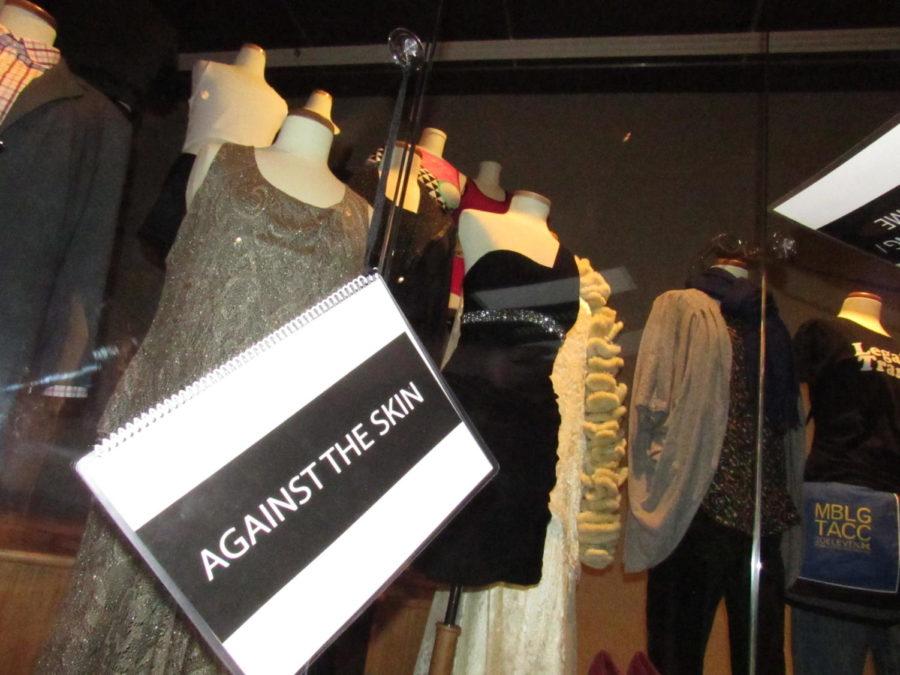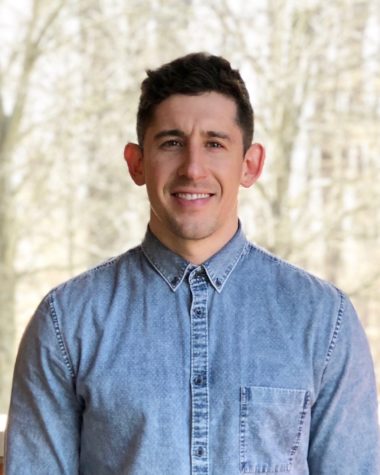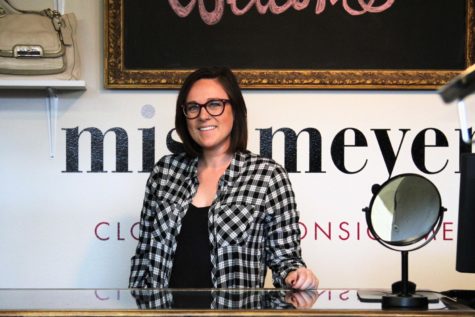Queer clothing now exhibited on ISU campus
February 9, 2018
The opening ceremony of an exhibit titled Queer Fashion and Style: Stories from the Heartland opened Friday night in the Textile and Clothing Museum located in 1015 Morrill Hall. The exhibit opening began with a lecture chronicling the exhibit itself and what it took to build the exhibit and the importance of giving a narrative to the history of queer fashion history that has been forgotten.
Dr. Kelly Reddy-Best, assistant professor in the department of apparel, events, and hospitality management was the curator of this exhibit and the lead researcher of the study that created the exhibit. Dana Goodin, graduate assistant in apparel, events, and hospitality management and Eulanda Sanders, AESHM Department Chair and professor in textiles and clothing were also co-curators of this exhibit.
The goal of this exhibit and research project was to try to define and narrate a history that has typically been forgotten about. According to Goodin, most of our clothing history in the U.S. within museums consists of wealthy white men and women.
Unfortunately, that was one thing that made this project difficult was that it was hard to find objects of people who, throughout history, were marginalized. Fortunately, today the history of queer clothing is able to come to the forefront and is able to be expressed in front of the public.
“I don’t think people were so much resistant to telling these stories, they just don’t think of it in fashion history because we live in a society that’s dominated by white men and that’s just who we place value on, especially that tends to be who we talk about in museum,” Goodin said. “A lot of history has been the dress of wealthy white women and I think particularly the fashion history of LGBTQ and indigenous people is rising to the forefront but the people who’ve been doing fashion history haven’t really been delving into those areas yet.”
The opening ceremony of the exhibit began with a lecture by Sanders, Reddy-Best and Goodin. The lecture chronicled and summarized the exhibit, which includes the year-long research project that it took to create the exhibit.
Reddy-Best and Goodin showed with pictures on a slide show the different types of queer styles that they found in the Midwest throughout their research. Their research was unique in that it consisted of interviews and looks into the closets of several different queers throughout the Midwest.
The pair were able to distinguish a few different distinct styles and important aspects of queer clothing. Each different aspect of queer styles had its own section within the exhibit, as well as binders that explained what they were and their owners’ stories behind them.
An unique part of this exhibit was the place within the exhibit that consists of two headphones and TV showing the taped interviews of the queer owners of the clothes throughout the exhibit. Anyone is able to use the headphones to listen to their stories and watch the TV as they talk and show off their garments.
One part of the exhibit was called, “Fitting the Stereotype.” People in this category played tug-a-war constantly wondering if what they were wearing was “too gay” or “not gay enough.” This exhibit consisted of one mannequin dressed in a flannel shirt and denim pants and other dressed in a Chicago Bulls t-shirt and hand-repaired cargo shorts. Shoes in this category include white Doc Martens and Birkenstocks.
Another part of this exhibit was called, “Overtly Proud.” This included a subcategory called, “Getting Political,” which is an obvious part of LGBTQ dress as they have struggled to gain their rights throughout history. This category included several different kinds of clothing that would showcase queers being proud of their sexuality.
A lot of this category included graphic tees such as the “Legalize Trans” graphic tees and the obvious rainbow of colors that represent the gay community. Another subcategory of “Overtly Proud” was called “Pride/ Temporary Spaces.” This category originated from spaces throughout communities that welcome gays and allowed them to be open with their sexuality.
One place in Ames, once called “Dungeon’s Deli,” and now called “Mother’s Pub,” has always welcomed gays. So wearing t-shirts representing “Dungeon’s Deli,” and now “Mother’s Pub,” as well as any other businesses that support gays is also a part of queer dress. These outfits consist of graphic shirts typically with denim pants to go along with them. This category also included items such as the “OC Pride” shirt, rainbow tutus, and teal cowboy boots.
“Feminine Leaning/High Femme,” was another category within the exhibit. People within this category refer to their style as “high in femininity.” Within this exhibit there was a gold dress; a black and gold pantsuit with a black belt and a high heel lace-up boot; a black dress with a rhinestone waistline; a white lace dress with a boa; and one last mannequin with black pants, with a flower print top, a sweat, a blue scarf, glasses and pink flats.
“Masculine of Center / Butch,” was another category within the exhibit that showcased clothing that was rather more masculine. On a casual day, this aesthetic included a green sweater, an orange shirt, and tan cargo shorts and a red shirt with blue casual pants. On a formal occasion this aesthetic consisted of a white button down, a blue tie, and blue dress cargo pants; a white button down, a pink tie, a gray vest, and a blue pleated front; and a grey suit, and a pink plaid button down.
“Queer Crip” was another category of clothing that aimed at fitting the bodies of everyone including queers, the disabled, and body image fitting. This category of clothing consisted of unique garments with multiple different colors that fit against the skin and can be used for any body type.
Another category, called, “Against the Skin,” included undergarments or garments that are against the skin. These garments can vary for different types of people throughout the LGBTQ community. Several different fashion brands have recognized and responded to the needs of the these people and have created garments that assist people that have never before had help in these areas.
One brand, “All is Fair in Love and Wear,” was also showcased in the exhibit, with its Director, Christian Dominique, there to inform exhibit-goers of their product. All is Fair in Love and Wear is a “brand that sells considerate compression-wear to the transgender and gender non-conforming community.” According to Dominique, on the current market for products such as theirs, there is a lot of compression wear for transgenders that are causing health issues such as broken ribs when people get a size too small, gastrointestinal issues, fluid in the lungs, and many other unwanted health problems.
All is Fair in Love and Wear has since created a health-conscious product that is comfortable for people and doesn’t cause them health issues, as well as compresses the chest tissue for those who identify as males but were born as women. This product goes under the clothing and comes in many different colors and sizes.
“Where I came in I was seeing this opportunity to take the garment that existed, that was trying to serve a need, and make improvements there so that it was actually functioning the way that it should and was held to a standard of quality that wasn’t seen anywhere else on the market,” Dominique said.
Other garments included in the category of “Against the Skin,” were a white binder, black packing underwear, and a prosthetic penis; multicolored lingerie top and bottom; and a pink sports bra with boxer briefs.
“Not Queer Enough” was another category within the exhibition that its members felt like they “weren’t queer enough” because their styles didn’t reflect the typical wear of their queer peers. To other people, they would be presumed as straight, whereas in other categories, their styles would automatically cause people to assume that they were gay. This category consisted a red jumpsuit and a black halter dress.
“Celebrating in Ceremony,” was a category that centered around graduation celebrations. This category is important because throughout history, in some professions, if people were outed as gay, they could be prohibited from pursuing their desired career.
Many universities have separate graduation ceremonies for the LGBTQ to celebrate that they made it through college and they are now able to go on and pursue their desired career, Reddy-Best said.
Clothing in this category consisted of a graduation gown, with a lavender graduation stole with triangle motifs, rainbow butterfly motifs, or at ISU, an ISU motif.
Throughout this research project what surprised Reddy-Best most was how much our clothing identifies who we are as people and how much it affects us.
“I think that it just highlighted how our identities are expressed through our clothing and how sexually can be really salient for some people and then maybe not for others. And so you really saw that in some of the stories, some people were very overtly gay and for other folks, they were not and they had to prove to themselves and they had to prove to other people that they were gay through their fashion,” Reddy-Best said.
Reedy-Best’s and Goodin’s work will be published within the coming months and this exhibit will be open to the public from Feb. 1 to April 14 in the Clothing and Textiles Museum located in 1015 Morrill Hall. Their hours are 11 a.m. to 4 p.m. Monday through Friday.













